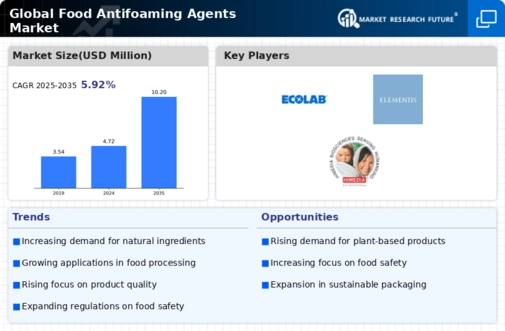Market Share
Food Antifoaming Agents Market Share Analysis
The Food Antifoaming Agents Market, a critical component of the food and beverage industry, strategically positions itself to navigate the complexities of food processing and maintain a competitive edge. Companies in this sector employ various market share positioning strategies, including product differentiation, cost management, and innovation, to cater to the diverse needs of food manufacturers and processors.
Product differentiation is a fundamental strategy in the Food Antifoaming Agents Market. Companies aim to distinguish their antifoaming agent offerings by emphasizing unique characteristics such as formulation, compatibility with different food processes, or targeted applications. For instance, a company might highlight its silicone-based antifoaming agent as ideal for high-temperature food processing, appealing to manufacturers in industries like frying or baking. This differentiation not only attracts food processors with specific production requirements but also contributes to building a distinct brand identity in a market where customization is highly valued.
Cost leadership is another crucial market share positioning strategy in the Food Antifoaming Agents Market. Companies strive to become the cost-effective providers of high-quality antifoaming agents by optimizing production processes, sourcing raw materials efficiently, and achieving economies of scale. This cost-conscious approach resonates with a broad customer base, particularly in industries where production costs play a significant role in decision-making. Becoming a cost leader allows companies to offer competitive prices while maintaining the efficacy and quality of their antifoaming agents, securing a larger market share.
Innovation plays a pivotal role in the Food Antifoaming Agents Market, with companies investing in research and development to create advanced formulations or application-specific solutions. Staying ahead of technological advancements enables companies to introduce antifoaming agents with improved stability, compatibility, or ease of use in various food processing applications. This innovation-centric approach not only addresses evolving customer needs but also positions companies as leaders in providing cutting-edge solutions for the food and beverage industry.
Strategic partnerships and collaborations are integral to market share positioning within the Food Antifoaming Agents industry. Companies often form alliances with food manufacturers, research institutions, or other players in the food processing ecosystem to enhance product development, explore new applications, and expand market reach. Collaborative efforts can lead to improved understanding of specific industry challenges, the development of tailor-made antifoaming solutions, or the creation of sustainable and eco-friendly options, ultimately strengthening a company's market position.
Geographical expansion is a significant strategy in the Food Antifoaming Agents Market, allowing companies to tap into new markets with diverse food processing needs. This expansion may involve adapting products to meet regional preferences, complying with local regulations, and establishing distribution networks. By understanding and catering to the unique challenges faced by food processors in different regions, companies can broaden their market share globally.
Customer-centric strategies are paramount in the Food Antifoaming Agents Market, where food processors seek reliable, efficient, and safe solutions. Companies focus on building trust through transparent communication, providing detailed information about the performance and safety of their antifoaming agents, and ensuring compliance with food safety regulations. Engaging with customers through technical support, educational initiatives, and industry events helps companies establish a strong connection with their audience, fostering brand loyalty and solidifying market share.






Leave a Comment